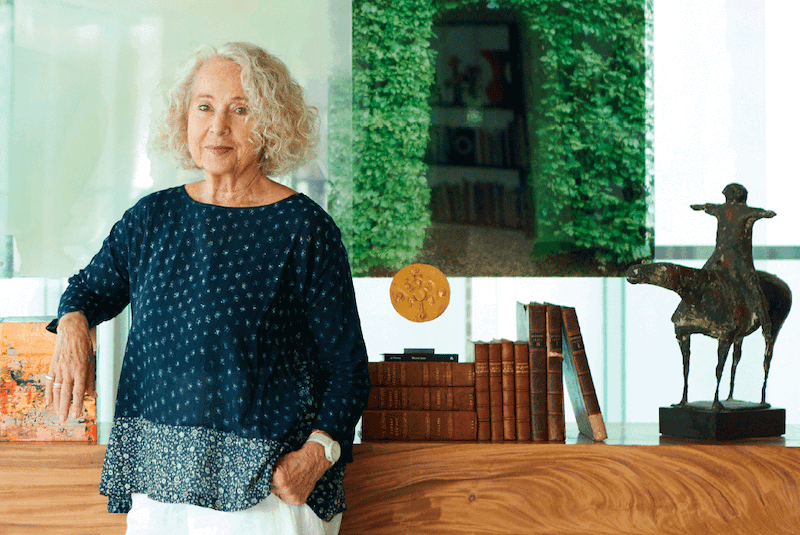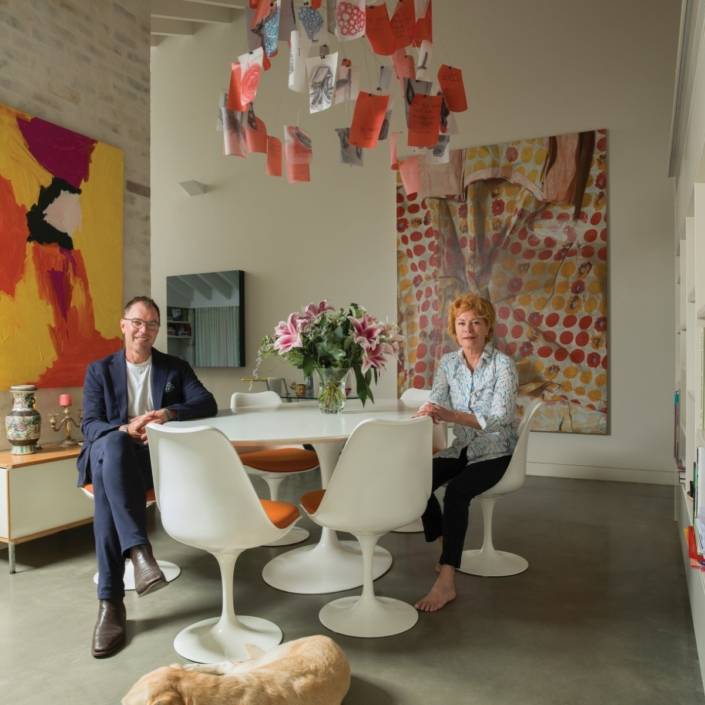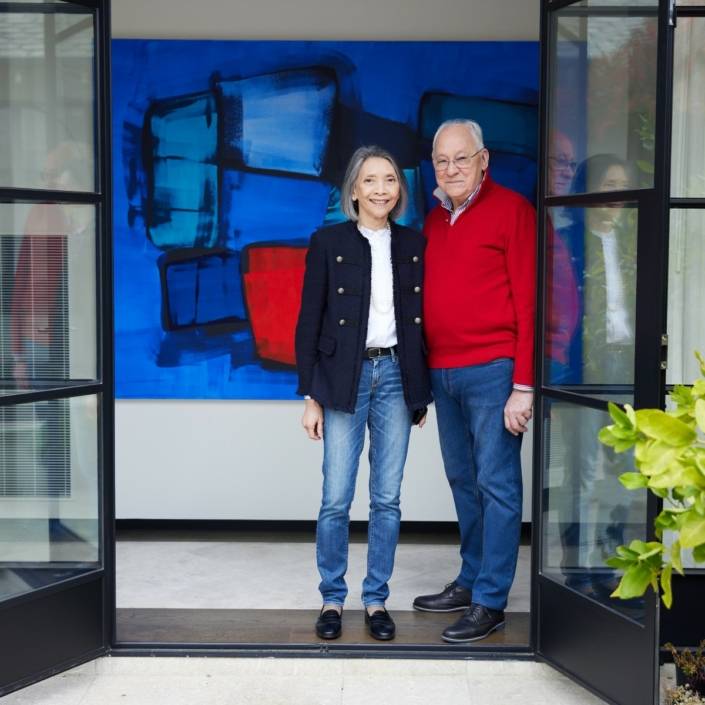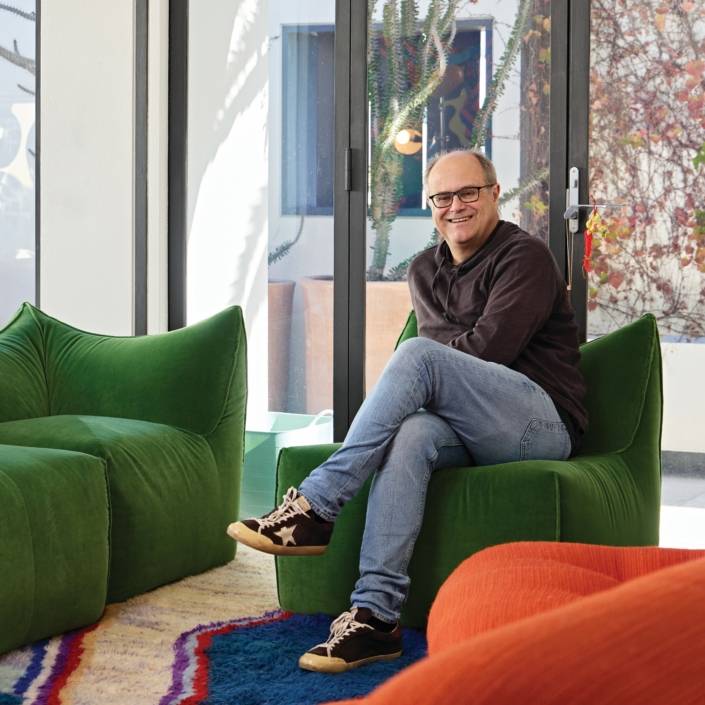Ginny Green: 20 years later
Two decades after she was profiled in Art Collector’s inaugural issue, Ginny Green no longer resists the label of “collector”.
Words: Jane O’Sullivan
Photography: Zan Wimberley
Two decades after she was profiled in Art Collector’s inaugural issue, Ginny Green no longer resists the label of “collector”.
When Art Collector sat down with Ginny Green 20 years ago, she insisted she wasn’t a collector. Real collectors were the obsessives, the ones who hid artworks under their beds. And now? Does she feel the same? “No!” she laughs. “I think I’m a collector now.
Definitely.” Green rearranges her apartment in Sydney’s Potts Point several times a year to make room for new finds. Most recently it was for a pair of larrakitj poles by Nyapanyapa Yunupingu. There were similar poles in last year’s Biennale of Sydney, in a shadowy room where the poles seemed to float through the night like spirits.
Here, in Green’s bright waterside apartment, they are not as mysterious; more guards than ghosts. They watch over a home where every wall, plus a good deal of the floor and shelf space, has been given over to art. Still, Green considers herself “pretty selective” as these things go.
When she and her husband Leslie Green moved to Potts Point six years ago, they had to pack up the family home in Point Piper. Choosing the artworks that could come with them was an excruciating process. “A lot of things were given away to my family, and some things are in storage. The things that I love the most came here,” she says. Light was one of the reasons they moved. Point Piper got terribly dark in the afternoons. “But you have to be careful what you wish for,” she laughs.
The Potts Point apartment has one long wall of glass that gives way to views over Cowper Wharf and the harbour beyond. The light floods in. It had her worried for a while. She had an immense Thomas Struth photograph assessed to see if the colour was fading and luckily it passed the test, but other works have been moved to the shelter of the hallway. For one of the most exposed positions in the living room, she sought out a large plate glass piece by Zhao Zhao. It’s cracked with bullet holes, but the violence of the piece is undercut – rather unexpectedly – by the reflection of Sydney Harbour Bridge on its surface. “I love the reflections,” says Green. “There are a lot of reflections in this apartment. You get them everywhere.”
Conversations like this are bubbling away all over the place – some planned, some not so much. Out on the veranda, a knotted steel girder by James Angus mimics the curves of a carpark ramp down below. In Leslie’s study, spiky Robert Klippels flank a set of Leslie’s old tools from his long career as a dentist. And in the kitchen, Eugenia Raskopoulos’ photograph of used brown wrapping paper is a quiet ode to everyday waste.
A recent work by her daughter, the ceramicist Donna Green, sits alongside an arresting camera obscura image by Vera Lutter. At first glance there’s not a lot to connect the earthy, wood-fired ceramic pot with the slick Lutter, a high contrast image of New York as seen from a clock tower.
But Green leans in. “My daughter lives just over here,” she says, pointing to a neighbourhood of buildings visible through the clock face. She steps back, regarding the Lutter once more. “I quite like the way that time has stopped,” she says softly. “We can always be living in the present.”
Another frozen chip of time rests on a nearby coffee table: an issue of the New York Times from 13 June, 1985 wrapped in clear plastic and tied with rope by Christo. It came from Green’s mother, the collector and trailblazing philanthropist Loti Smorgon, who died in 2013. The gentle way Green handles the “little Christo” shows just how full of meaning it is for her. In fact, family comes up surprisingly often. A stark painting of a vase of flowers by John Brack, also from her mother, is in the bedroom.
A Picasso lithograph that she and and her siblings gave to her father, the late Victor Smorgon, now hangs in Leslie’s study. And then there are the mentions of artworks she has given to her own four children, like a large Debra Phillips photograph now with her son. Green shares her love of art through philanthropy too. “It’s in our heritage, my family’s heritage, to support people you believe in, who you think could do with support,” she says simply.
She applauds the local philanthropic community, which has grown so startlingly since Art Collector spoke to her 20 years ago. “People are more aware. And there are some wonderful people here in Sydney who do fantastic philanthropy, so generous,” she says.
Another change in that time has been the explosion of international art fairs and biennales. Green enjoys the Venice and Sydney biennales and has been to several art fairs, but it hasn’t changed much for her. The question of whether an artist is Australian or international is a non-issue. If she sees it and she loves it, that’s it.
Recently Green commissioned a piece from Chiharu Shiota. She saw a large work in the Venice Biennale and thought “maybe I’ll see if she does small works. So I found out and got this one.” It now sits on her desk in the living room, a tangle of white thread wrapped around a small cube frame. An open book is barely visible inside. I hesitate, thinking of the way Shiota’s installation in the last Biennale of Sydney was both a nest and a cage, and admit I find her work half comforting, half terrifying. “That’s why I like it,” Green says. “I like things that are a little bit off-centre, like the bullet holes in the glass.”
Green’s enthusiasm is infectious. Still standing in front of the Shiota, she marvels: “How does she do it? I like the mystery of the work too. You don’t quite know how she’s able to make such a beautiful thing.” 20 years on and she is as wide-eyed as ever.
This article was originally published in Art Collector issue 80, APR-JUN 2017.






